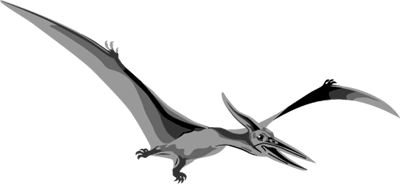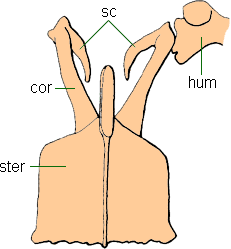Vertebrate Flight
PTEROSAURIAN FLIGHT

The first vertebrates to evolve true flight were the pterosaurs, flying archosaurian reptiles. After the discovery of pterosaur fossils in the 18th century, it was thought that pterosaurs were a failed experiment in flight, or that they were simply gliders, too weak to fly. More recent studies, including work done by UC Berkeley's Dr. Kevin Padian, have revealed that pterosaurs were definitely proficient flyers, and were no evolutionary failure; as a group they lasted about 140 million years (about as long as birds have)!
Pterosaurs are thought to be derived from a bipedal, cursorial (running) archosaur similar to Scleromochlus in the late Triassic period (about 225 million years ago). Other phylogenetic hypotheses have been proposed, but not in the context of flight origins. The early history of pterosaurs is not yet fully understood because of their poor fossil record in the Triassic period. We can infer that the origin of flight in pterosaurs fits the "ground up" evolutionary scenario, supported by the fact that pterosaurs had no evident arboreal adaptations. Some researchers have proposed that the first pterosaurs were bipedal or quadrupedal arboreal gliders, but these hypotheses do not incorporate a robust phylogenetic and functional basis. The issue is not yet closed.

 A generalized pterosaur pectoral girdle (sc= scapula, cor= coracoid, hum= humerus, ster= sternum). Adapted from Padian 1985. |
|
Early pterosaurs (such as Dimorphodon) had long tails that assisted balance, but later pterosaurs (such as Pterodactylus) had no tails, and so may have been more maneuverable flyers. The most derived pterosaurs, such as Pteranodon and Quetzalcoatlus, were so large that soaring was the only feasible option; these were the largest flyers ever known to cast a shadow on the Earth's surface.